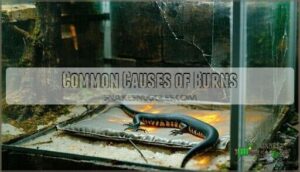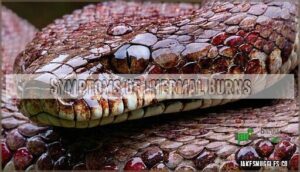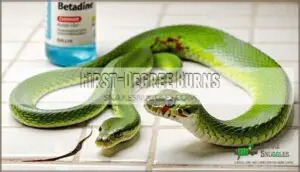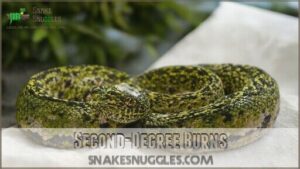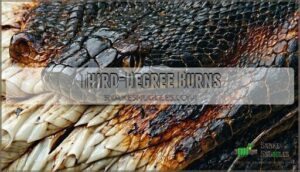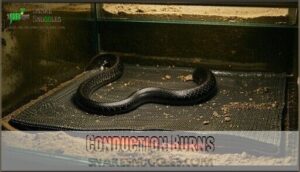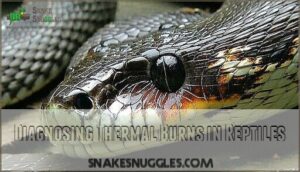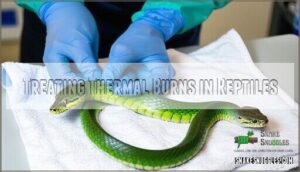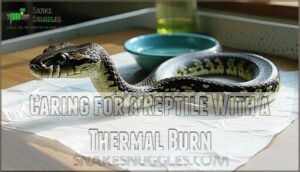This site is supported by our readers. We may earn a commission, at no cost to you, if you purchase through links.
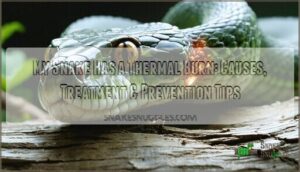 You’re worried because your snake has a thermal burn. Act quickly, as prompt treatment is key.
You’re worried because your snake has a thermal burn. Act quickly, as prompt treatment is key.
Check for symptoms like skin discoloration, blisters, and behavioral changes. Thermal burns can be caused by heat sources, poor ventilation, or incorrect temperature settings.
You’ll need to get your snake to a vet for proper care and treatment. With the right help, your snake can recover.
Now, let’s take a closer look at what might have caused the burn and how to prevent it from happening again, so you can give your snake the best chance to heal.
Table Of Contents
- Key Takeaways
- Recognizing Thermal Burns in Reptiles
- Understanding The Causes of Thermal Burns
- Diagnosing Thermal Burns in Reptiles
- Treating Thermal Burns in Reptiles
- Preventing Thermal Burns in Reptiles
- Caring for a Reptile With a Thermal Burn
- Frequently Asked Questions (FAQs)
- Why does my reptile burn?
- What causes thermal burns in reptiles?
- Can Snakes get burnt on unprotected heat sources?
- What happens if a snake gets too hot?
- What happens if a reptile is too hot?
- How do you treat a burn on a snake?
- How Do Reptiles Get Burned?
- What Are Some Of The Causes Of Burns?
- How Do I Prevent My Reptile From Burning Itself?
- What Are The Symptoms To Watch Out For?
- Conclusion
Key Takeaways
- You’ll need to act quickly if you suspect your snake has a thermal burn, as prompt treatment is key to preventing serious complications and promoting healing.
- It’s crucial to recognize the symptoms of thermal burns in snakes, including skin discoloration, blisters, and behavioral changes, to provide proper care and treatment.
- You can prevent thermal burns in your snake by setting up a safe and well-designed enclosure, using thermostats, placing heat sources safely, and creating thermal gradients to prevent overheating.
- If your snake does get a thermal burn, you’ll need to provide proper wound care, manage pain, and possibly administer antibiotics, and it’s essential to monitor for complications, such as infection, dehydration, and shedding issues, to ensure your snake recovers fully.
Recognizing Thermal Burns in Reptiles
You’re checking your snake’s enclosure and notice some suspicious signs of injury, so it’s vital to recognize thermal burns in reptiles.
Recognize thermal burns in reptiles to provide proper care and treatment for your snake’s injuries.
If you suspect your snake has a thermal burn, it’s imperative to identify the symptoms, such as skin discoloration or blisters, to provide proper care and treatment.
Common Causes of Burns
You’re setting up your reptile’s enclosure, but beware of heat source types, poor design, and thermostat failure, which can cause burns, especially with reptile heating pads, due to electrical issues.
Affecting reptile mobility, and creating burn hazards, so guarantee enclosure safety to prevent reptile burn causes.
Symptoms of Thermal Burns
You’ll notice skin discoloration, blister appearance, or scale damage.
Look out for:
- Behavioral changes
- Pain manifestation
- Blister appearance
- Scale damage, indicating a thermal burn.
These reptile burn symptoms can signal a serious issue, so monitor your snake’s health closely, watching for snake skin injury or snake thermal burn signs like burn blister snake.
First-Degree Burns
Sunbathing gone wrong? If your snake has a first-degree thermal burn, you’ll see red skin, slight bruising under the scales, maybe singed spots, and some tiny blisters.
These superficial burns are like a sunburn for your scaly friend—uncomfortable but usually not serious. Gently rinse the area under cool water for 20 minutes.
Afterward, a soak in povidone iodine helps speed up healing. Dab on Betadine ointment for extra protection.
Most snakes shed off scale damage as they heal, so don’t worry—healing time is typically under a week with these home remedies and basic preventative measures.
| Symptom | Action |
|---|---|
| Reddened skin | Rinse with cool water |
| Bruising | Apply iodine solution |
| Small blisters | Use Betadine ointment |
| Singed scales | Monitor for shedding |
| Mild discomfort | Observe daily healing |
Second-Degree Burns
Second-degree burns in snakes can sneak up on you—one minute your buddy’s basking, the next, you’ve got blister formation, oozing wounds, and a snake that’s clearly hurting.
Jump into reptile burn treatment mode: pain management, wound cleaning, and infection risk control are key.
Stick with your treatment protocols, like Silvadene cream, and keep a close eye on wound healing.
When in doubt, ask your vet!
Third-Degree Burns
Spotting third-degree burns on your snake—think charred skin or scales gone white—means serious business.
You’ll need urgent vet help for deep wounds like these.
Treatment might include Eschar Removal or, in tough cases, Grafting Options.
Watch for Long-Term Complications, manage scarring, and know that amputation risks are real.
Quick wound care is key to effective reptile burn treatment.
Understanding The Causes of Thermal Burns
You’re likely wondering what caused your snake’s thermal burn, and understanding the possible causes is vital to prevent future incidents.
You’ll need to examine factors like heat sources, enclosure design, and your snake’s ability to perceive heat to get to the root of the problem.
Convection Burns
As you manage your snake’s environment, be aware that convection burns occur from warm airflow or water burns.
Verify proper enclosure design and ventilation to prevent thermal burns.
Air currents can cause burns, so monitor your snake’s habitat to prevent hot spots and ventilation issues, key to reptile burn treatment and snake care emergency.
To guarantee consistent temperatures, consider using reptile thermostats for regulation.
Radiant Burns
You’re likely familiar with sunburns, but radiant burns in snakes occur from artificial heat sources, like a heat lamp.
To prevent this:
- Monitor lamp distance
- Adjust bulb wattage
- Observe basking behavior
- Control heat absorption to prevent scale damage and thermal burns.
Conduction Burns
You can prevent conduction burns by handling heat sources safely.
Hot rocks and heat mats can cause burns if your snake touches them.
Use safe surface materials and follow prevention tips to minimize burn severity and guarantee your snake’s safety from thermal burns.
Reptile Perception of Heat
As you care for your snake, remember they’ve unique heat-sensing organs.
They seek warmth, but may not react to pain like mammals.
Watch for subtle behavioral responses, like hunched posture.
- Heat Seeking Instincts
- Thermoregulation Issues
- Pain Thresholds
Diagnosing Thermal Burns in Reptiles
You’re trying to figure out if your snake has a thermal burn, and you’re not sure where to start.
You’ll need to examine your snake’s skin, get a sense of its behavior, and possibly run some tests to determine the severity of the burn.
Physical Examination
You’ll undergo a physical examination, including a skin assessment, to check for behavioral signs and mobility defects.
Here are key points:
- Reptile posture
- Skin discoloration
- Scale abnormalities, helping assess thermal burns and burn severity.
Skin abnormalities may also signal potential underlying illness, which is a critical aspect to consider, as it may indicate a potential issue.
History From The Pet Parent
You’ll need to share enclosure details, heat sources, and the burn timeline with your vet.
Describe any behavioral changes, recent shedding, or snake husbandry issues to help them diagnose thermal burns and provide reptile burn first aid.
Finding a reptile vet near you is essential.
Bloodwork and Laboratory Tests
Your reptile vet near me will likely recommend bloodwork and laboratory tests to get the full picture of your snake’s health.
CBC Analysis checks for signs of infection, while Electrolyte Levels reveal dehydration status.
Infection Markers help identify complications, and Organ Function tests confirm your snake’s body can handle treatment.
Culture Sensitivity testing may identify specific bacteria if infection develops.
Assessing The Severity of The Burn
You’re evaluating the burn severity of your snake’s thermal burn.
Evaluate burn depth, pain indicators, and tissue damage to determine the severity, considering infection risk and healing prognosis, which helps classify the burn and guide treatment for your snake’s thermal burn severity assessment, focusing on complete concepts.
Treating Thermal Burns in Reptiles
You’re taking the right step by seeking help for your snake’s thermal burn, and now it’s time to focus on treatment.
You’ll need to provide proper wound care, manage your snake’s pain, and possibly administer antibiotics to help them recover from the burn.
Second- and Third-Degree Burns
Once you’ve figured out your snake’s burn severity, second- and third-degree burns call for prompt snake burn veterinary care.
Your vet will step in with Wound Care—think gentle cleaning and antibiotics.
Fluid Therapy helps fight dehydration, while Debridement clears out dead tissue.
Reptiles are ectothermic and require external heat sources to regulate their body temperature.
Watch closely for Infection Risk. The sooner you handle these thermal burns, the better your snake’s shot at healing.
Pain Management
Even one tough burn can leave your snake hurting, so pain management really matters.
Your vet may prescribe pain medications, like opioid use for severe cases or NSAIDs for milder pain.
Reptile pain isn’t always obvious, so stick to the plan, and follow your vet’s advice closely—those opioid medications, antiinflammatory medications, and topical treatments can make all the difference.
Supportive care and wound cleaning help too.
Wound Care and Debridement
Once pain management is sorted, focus on wound care and debridement for your snake’s burn.
Start with gentle wound cleaning using saline. Remove dead tissue with careful reptile burn debridement, then try these tips for thermal burn wound care:
- Apply topical antibiotics
- Use non-stick dressing choices
- Change bandages daily
- Prioritize infection control
- Watch for swelling or discharge
Preventing Thermal Burns in Reptiles
You don’t want your snake getting a nasty surprise from a hot rock or lamp, so let’s look at simple ways to set up a safe, comfy home.
It’s easier than you think to keep burns at bay—just a bit of planning and a watchful eye go a long way to create a comfy environment.
Proper Cage Design and Ventilation
After treating burns, let’s focus on stopping them before they happen. Proper reptile enclosure design is key! Think of it as building a safe haven.
Here’s how to prevent burns with good cage design and reptile ventilation:
- Cage Size: Provide ample space for movement.
- Airflow Dynamics: Good reptile ventilation prevents overheating.
- Thermostat Placement: Use thermostats to regulate temperature.
- Humidity Control: Maintain proper reptile humidity control.
To prevent burns, it’s essential to avoid direct contact with heating elements. Consider your basking spot. Good reptile temperature monitoring is a must.
With these tips, you’re well on your way to reptile burn prevention.
Safe Heat Source Placement
You set up heat sources, ensuring a safe distance and thermostat use for basking spot safety, preventing reptile heating pad burns and other hazards, in your cage design with alternative heat sources.
Thermostats regulate temperature ensuring a comfortable and stable environment for your snake.
| Heat Source | Distance | Safety |
|---|---|---|
| Heat Lamp | 12 inches | High |
| Heat Mat | 6 inches | Medium |
| Heat Cable | 3 inches | Low |
The use of alternative heat sources is crucial in your cage design to prevent hazards and ensure the well-being of your snake.
Monitoring Temperature and Humidity
Beyond proper placement, your reptile enclosure needs consistent temperature and humidity monitoring to prevent dangerous overheating.
Digital hygrometers and thermostat calibration guarantee your snake stays within safe parameters while maintaining proper temperature gradients. Maintaining proper humidity is easier with digital reptile readers.
- Set up remote monitoring systems – Track temperature and humidity levels continuously, even when you’re away from home.
- Calibrate your thermostat monthly – Use a separate thermometer to verify your thermostat’s accuracy and prevent deadly temperature spikes.
- Maintain species-specific humidity levels – Monitor with digital hygrometers to prevent dehydration and support healthy shedding cycles.
Avoiding Common Burn Hazards
Heat source safety disasters happen when unscreened incandescent lights burn unsuspecting snakes.
Avoid these reptile burn hazards by installing protective guards around heat sources and maintaining proper distance from basking spots.
Regular inspections of your thermostat prevent malfunctioning hot rocks and heat mats from overheating.
Smart enclosure design includes adequate ventilation and substrate barriers for under-tank heating.
Remember: thermostat importance can’t be overstated for hazard mitigation in your proper snake enclosure.
Caring for a Reptile With a Thermal Burn
If your snake has suffered a thermal burn, quick action and proper care can make the difference between a full recovery and serious complications.
Act fast to help your snake heal from thermal burns
You’ll need to assess the burn’s severity and provide appropriate treatment while watching for signs that require immediate veterinary attention.
Home Treatment and Care
You’re now caring for your snake at home.
Use cool water rinses and topical antibiotics to promote wound healing and prevent infection, ensuring proper hydration and monitoring shedding in a safe home environment.
Consider using a reptile-safe antibiotic ointment to help prevent infection.
When to Seek Veterinary Care
If your snake’s burn is large, deep, or infected, seek veterinary care.
Your vet will assess burn severity and provide guidance on treatment, including pain management, to prevent a worsening condition and promote healing from thermal burns.
Monitoring for Complications
After veterinary attention, reptile burn monitoring is very important. Watch your snake closely for reptile burn complications.
Infection Signs, such as redness or discharge, need immediate attention.
- Dehydration Risks: Sunken eyes or dry skin.
- Shedding Issues: Changes in shedding.
- Nutritional Needs: Decreased appetite.
Secondary Infections are a concern. Stay alert for changes in behavior. Call your vet if you notice anything unusual while providing wound care and antibiotics. Infection prevention is key!
Promoting Healing and Reducing Scarring
To promote healing and reduce scarring from thermal burns, focus on a healing diet rich in protein and vitamins.
Keep your reptile hydrated with fresh water to minimize infection and support burn recovery.
Topical treatments and antibiotics, as directed by your vet, will also aid in wound care.
A balanced approach to long-term care can help reduce scar tissue and by following these steps, you’ll be well on your way to helping your reptile recover from thermal burns and minimizing scarring.
Remember, proper care and attention can make a big difference in reptile burns healing and overall health.
Frequently Asked Questions (FAQs)
Why does my reptile burn?
You’re likely causing your reptile’s burn due to improper heat source setup, direct contact with heat, or malfunctioning equipment, leading to thermal burns from conduction, convection, or radiation.
What causes thermal burns in reptiles?
You’ll find thermal burns in reptiles are often caused by improper heat sources, direct contact with hot objects, or poor enclosure design, leading to painful injuries and potential health issues.
Can Snakes get burnt on unprotected heat sources?
Thou shalt beware, yes, you can get your snake burnt on unprotected heat sources, like lamps or hot rocks, if they’re not set up correctly, it’s a serious burn risk.
What happens if a snake gets too hot?
You’ll notice your snake getting lethargic, showing skin discoloration, and blistering if it gets too hot, indicating a potential thermal burn that requires immediate attention and care.
What happens if a reptile is too hot?
You’ll see signs like skin discoloration, blisters, and changes in behavior if a reptile is too hot, indicating a potential thermal burn that requires immediate attention and care.
How do you treat a burn on a snake?
Gently grasp the situation, you’ll need to clean the burn with sterile saline, apply topical antibiotics, and manage pain to help your snake heal from the thermal burn.
How Do Reptiles Get Burned?
You can accidentally burn your reptile with heat sources like lamps, hot rocks, or malfunctioning mats, causing painful burns and injuries if not properly set up or monitored regularly.
What Are Some Of The Causes Of Burns?
You’ll find burns are often caused by heat sources like lamps, hot rocks, or malfunctioning mats, which can lead to direct contact, convection, or radiant burns in reptiles.
How Do I Prevent My Reptile From Burning Itself?
You can prevent burns by using thermostats, placing heat sources safely, and creating thermal gradients, ensuring your reptile’s enclosure is well-designed and safe.
What Are The Symptoms To Watch Out For?
Watch for skin discoloration, blisters, and changes in behavior, as these can be telltale signs that you’ll need to take action to help your snake feel better soon.
Conclusion
Burning questions about your snake’s thermal burn will fade away with proper care.
You’ve taken the first step by learning about thermal burns, now it’s time to act.
If your snake has a thermal burn, get it to a vet ASAP – your snake’s recovery depends on it, so don’t delay, especially since you’re worried that my snake has a thermal burn.

